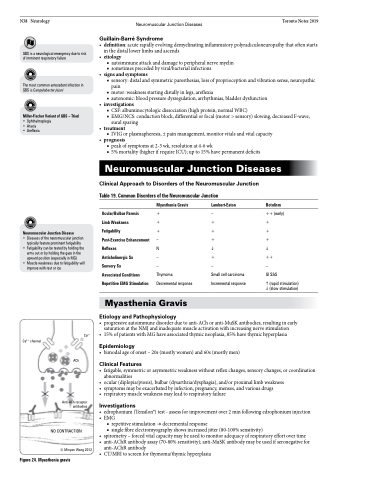Page 780 - TNFlipTest
P. 780
N38 Neurology
Neuromuscular Junction Diseases Toronto Notes 2019
Guillain-Barré Syndrome
• definition:acuterapidlyevolvingdemyelinatinginflammatorypolyradiculoneuropathythatoftenstarts in the distal lower limbs and ascends
• etiology
■ autoimmune attack and damage to peripheral nerve myelin ■ sometimes preceded by viral/bacterial infections
• signsandsymptoms
■ sensory: distal and symmetric paresthesias, loss of proprioception and vibration sense, neuropathic
pain
■ motor: weakness starting distally in legs, areflexia
■ autonomic: blood pressure dysregulation, arrhythmias, bladder dysfunction
• investigations
■ CSF: albuminocytologic dissociation (high protein, normal WBC)
■ EMG/NCS: conduction block, differential or focal (motor > sensory) slowing, decreased F-wave,
sural sparing
• treatment
■ IVIG or plasmapheresis, ± pain management, monitor vitals and vital capacity
• prognosis
■ peak of symptoms at 2-3 wk, resolution at 4-6 wk
■ 5% mortality (higher if require ICU); up to 15% have permanent deficits
Neuromuscular Junction Diseases
GBS is a neurological emergency due to risk of imminent respiratory failure
The most common antecedent infection in GBS is Campylobacter jejuni
Miller-Fischer Variant of GBS – Triad
• Ophthalmoplegia • Ataxia
• Areflexia
Clinical Approach to Disorders of the Neuromuscular Junction
Table 19. Common Disorders of the Neuromuscular Junction
Neuromuscular Junction Disease
• Diseases of the neuromuscular junction typically feature prominent fatigability
• Fatigability can be tested by holding the arms out or by holding the gaze in the
upward position (especially in MG)
• Muscle weakness due to fatigability will
Ocular/Bulbar Paresis
Limb Weakness
Fatigability
Post-Exercise Enhancement Reflexes
Anticholinergic Sx
Sensory Sx
Associated Conditions Repetitive EMG Stimulation
Myasthenia Gravis
+
+
+
–
N
–
–
Thymoma Decremental response
Lambert-Eaton
–
+
+
+
+
–
Small cell carcinoma Incremental response
Botulism
++ (early) +
+
+
++
–
GI S&S
(rapid stimulation) (slow stimulation)
improve with rest or ice
Myasthenia Gravis
Etiology and Pathophysiology
Ca2+ channel
Ca2+
ACh
Anti-ACh receptor antibodies
NO CONTRACTION
© Minyan Wang 2012
• progressiveautoimmunedisorderduetoanti-AChoranti-MuSKantibodies,resultinginearly saturation at the NMJ and inadequate muscle activation with increasing nerve stimulation
• 15%ofpatientswithMGhaveassociatedthymicneoplasia,85%havethymichyperplasia
Epidemiology
• bimodalageofonset–20s(mostlywomen)and60s(mostlymen)
Clinical Features
• fatigable,symmetricorasymmetricweaknesswithoutreflexchanges,sensorychanges,orcoordination abnormalities
• ocular(diplopia/ptosis),bulbar(dysarthria/dysphagia),and/orproximallimbweakness
• symptomsmaybeexacerbatedbyinfection,pregnancy,menses,andvariousdrugs
• respiratorymuscleweaknessmayleadtorespiratoryfailure
Investigations
• edrophonium(Tensilon®)test-assessforimprovementover2minfollowingedrophoniuminjection
• EMG
■ repetitive stimulation → decremental response
■ single fibre electromyography shows increased jitter (80-100% sensitivity)
• spirometry–forcedvitalcapacitymaybeusedtomonitoradequacyofrespiratoryeffortovertime
• anti-AChRantibodyassay(70-80%sensitivity);anti-MuSKantibodymaybeusedifseronegativefor
anti-AChR antibody
• CT/MRItoscreenforthymoma/thymichyperplasia
Figure 24. Myasthenia gravis


